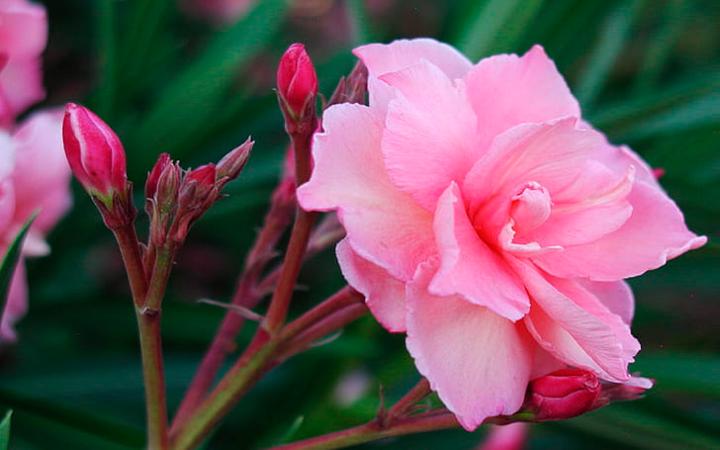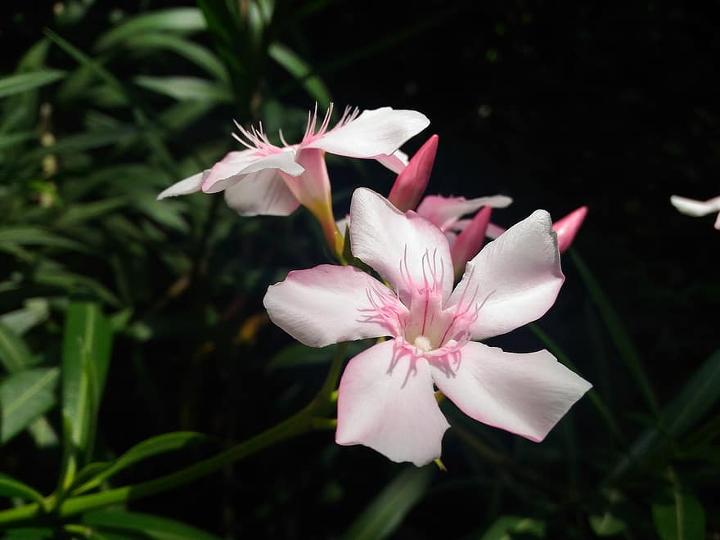Oleander Plant
Oleanders, shrubs with fast growth, thrive in well-drained soil and full sun. With low moisture needs, Oleanders are valued for their colorful and fragrant flowers, commonly used in landscaping and as ornamental shrubs.

Habit
Shrub
Height
2-6 m
Growth
Fast
Soil
Well-drained, loamy
Shade
Full Sun
Moisture
Low
Edible
No
Medicinal
No
Origin
Mediterranean, Asia
Climatic Condition
Subtropical, Temperate
Temperature (°)
20-30°C
Humidity (%)
50-70%
Potting media
Loamy, peat
Fertilizers
Balanced NPK (10-10-10)
Watering
Regular, moderate
Plant Weight
500-1000 g
Flowering Time
Spring, Summer
Soil Ph level
6.0 - 7.5
Water Ph level
6.0 - 7.0
Soil EC
1-2 dS/m
Yield Per Plant
Ornamental flowers
NPK ratio
10:10:10
life Span
Perennial
Health Benefits
Ornamental flowers, toxic if ingested
Suggested Grow Media or Potting Mix ?
50% sandy soil, 30% compost, 20% perlite
Suggested Fertigation/Fertilizers
Fertilize every 4 weeks with a balanced, water-soluble fertilizer.
Common Diseases and Remedies
Leaf Scrotch
Margin of leaves turns deeper yellow and leaves eventually dies
Spray Fermented Buttermilk
HEALTH BENEFITS
⚠️ Toxicity Warning: All parts of Oleander are highly toxic if ingested. However, in controlled doses, some extracts have been explored for potential medicinal uses, such as cardiac support and cancer research.
What Is An Oleander?
Oleander is a beautiful but poisonous plant commonly found in gardens and landscapes. The flowers vary in color, including white, pink, and red, but all parts of the plant contain toxic compounds, so it's important to handle them with care and keep them out of the reach of children and pets. is. Despite its toxicity, oleander is popular for its ornamental value and drought tolerance.

What Are The Different Types Of Oleander?
1. Hardy Red
Known for its bright red flowers.
2. Calypso
Features pink double flowers and yellow neck.
3. Petit Pink
A dwarf variety with pink flowers
4. White Cascade
It blooms white flowers and has a tendency to weep.
5. Sister Agnes
Characterized by white flowers and compact growth

How To Care For Oleander?
1. Location
Oleander plants usually grow in temperate climates and are often found in areas with Mediterranean or subtropical climates. Prefers full sun and well-drained soil. Therefore, the ideal location for oleander is southern Europe, the Mediterranean, parts of the Middle East, the southern United States and similar regions with a similar climate.
2. Sunshine
"Oleander Sunshine" is a poetic phrase that suggests the warmth and brightness of the delicate flower oleander. It can symbolize giving consideration, attention, and positivity to someone or something that is vulnerable or in need of care.
3. Soil
Oleander usually grows in well-drained soil with a slightly acidic to neutral pH. A suitable potting mix for container-grown oleanders will be equal parts garden soil, sand, and perlite or vermiculite to ensure drainage. Alternatively, you can use a commercial potting mix designed for flowering shrubs. Amend the soil with organic matter such as compost to improve texture and fertility. Do not forget to water your oleander regularly. However, to prevent root rot, wait until the soil is slightly dry between waterings.
4. Hydration
Oleander plants require regular watering, especially during hot, dry weather. Water thoroughly and allow the soil to dry slightly between waterings. However, oleanders prefer well-drained soil, so be careful not to let the soil become soggy. Watering once or twice a week is usually sufficient. However, adjust watering according to weather conditions and soil moisture. Additionally, mulching around the base of your plants will help retain moisture in the soil.

5. Nourishment
Oleander is generally a low maintenance plant, but will benefit from occasional fertilization to promote healthy growth and flowering. Flowering shrubs can use a balanced fertilizer applied according to the manufacturer's instructions. Avoid over-fertilizing as it can harm the plant.
6. Issues
Yellow leaves can be a sign that your oleander is getting too much sun, and faded leaves mean it needs more light. Growth inhibition may also indicate insufficient light. Oleander prefers bright, indirect sunlight. Too much direct exposure can cause leaf scorch, which makes the leaves appear sunburned.
What Are The Benefits Of Oleander
Medicinal properties Oleander contains compounds such as oleandrin and digitoxigenin, which are being studied for their potential medicinal properties. Their effects on cancer cells and cardiovascular disease are being studied. Traditional Medicine In traditional medicine, oleander is used to treat various illnesses such as asthma, epilepsy, and skin diseases. However, these uses have not been scientifically tested and can be dangerous due to toxicity. Ornamental Value Oleander is highly valued for its ornamental value with its colorful flowers and evergreen leaves. It is often used in landscaping and gardening to add beauty to outdoor areas. Attract pollinators Oleander flowers attract bees, butterflies, and other pollinators, contributing to biodiversity and ecosystem health. Tolerance to harsh conditions Oleander is drought tolerant and can grow in a variety of soil types, making it suitable for landscaping in arid regions.

FAQs About Growing Oleander
1. How to maintain oleander plant?
Maintaining an oleander plant involves several key steps, Sunlight Ensure your oleander receives plenty of sunlight, ideally at least 6 hours of direct sunlight per day. Watering Water regularly, especially during dry periods. Oleanders are drought-tolerant but appreciate consistent moisture, especially when young. Soil Plant oleanders in well-draining soil. They don't like soggy conditions, so avoid overwatering and waterlogged soil. Fertilization Feed your oleander with a balanced fertilizer during the growing season (spring to early fall). Follow the instructions on the fertilizer package for the correct application rate. Pruning Prune your oleander to maintain its shape and size, and to remove dead or damaged branches. Wear gloves when pruning, as oleander sap is toxic.
2. What is mustard greens used for?
Cooking Particularly common in Asian and Southern cooking. It can be fried, sautéed, steamed, or added to soups and stews. Pickling Mustard greens can be pickled alone or as part of a mixed pickle. Garnish Can be used as a garnish to a variety of dishes, adding color and flavor.
3. How to care for mustard greens?
Follow these steps to care for mustard greens. Watering Mustard greens require a certain amount of moisture. Water regularly, especially during dry periods, to keep the soil evenly moist. Fertilization Use a balanced fertilizer or compost to provide necessary nutrients. Apply according to the instructions on the fertilizer package. Weeding Keep the area around mustard greens free of weeds as they can compete for nutrients and water. Mulch Place mulch around plants to retain moisture, suppress weeds, and regulate soil temperature. Pest Control Monitoring of pests such as aphids, caterpillars, and flea beetles. If necessary, use natural or organic methods such as hand-picking, insecticidal soap, and neem oil. Disease Management Look for signs of diseases such as downy mildew and powdery mildew. To reduce the risk of fungal infections, provide good air circulation around the plant and avoid overhead watering.
4. Which pot is suitable for growing mustard greens?
A pot that is at least 6 to 12 inches deep and 12 to 18 inches in diameter is suitable for growing mustard greens. Make sure there are drainage holes in the floor to avoid water seepage. Also, choose a pot made of a breathable material such as terracotta or plastic.
5. Where can I buy Takana?
Mustard greens can be purchased in a variety of places, including local grocery stores, supermarkets, farmers markets, and even online grocery delivery services. It is often sold in the produce section along with other leafy vegetables. If you prefer organic or specialty varieties, consider checking out specialty grocers and farmers who sell directly to consumers.